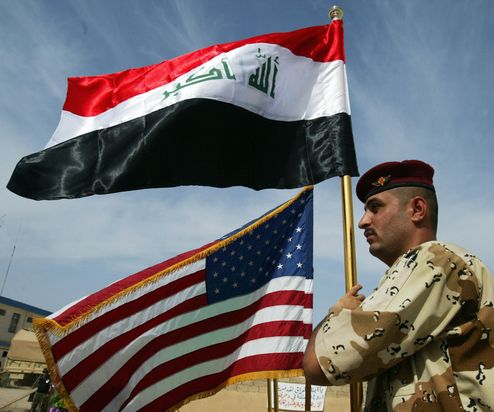 The importance of the Middle East region for the US stems from the fact that it is part of a wider geography which includes Europe and Asia, whose security has been one of the main American concerns since the 1900s.
The importance of the Middle East region for the US stems from the fact that it is part of a wider geography which includes Europe and Asia, whose security has been one of the main American concerns since the 1900s.
The Middle East has been considered a source of conflict since the 1948 war between Arabs and Israelis, affecting not only neighboring countries in Asia, Africa and Europe but also countries distant from it, such as the US and Australia. Thus, the importance of the Middle East to the US is an essential element of its global security system.
Washington perceives that failure to resolve conflicts in the region affects its national security as well as the security of its allies. This has been clear when a violent waves of attacks struck the United States and Western Europe in 2017 because the Middle East, though distant from the US in geography, is very influential in its domestic security and stability as well as prosperity.
Many other Middle East crises badly affect American stability and security, ranging from the influx of refugees from Syria, threats ofweapons of mass destruction including chemical weapons. The other issue that Mideast countries cause to the US is energy and oil as the Middle East oil producers either aggravate the performance of the American economy or improve it based on the prices of oil in the global market.
However, Americans believe that Russians won the first round of 2017 in the Middle East by winning the war in Syria, which has strengthened the position of the Kremlin internationally. This could be a very positive justification for the Americans to reconsider their status in the Mideast and how to counter Russia and China which are expanding their influence in the Middle East and Africa.
American concerns are linked to major developments in Syria that took place last year. These developments are also significant for the Kremlin, particularly in view of the forthcoming presidential elections in spring as they are not only linked to the strengthening of Russia’s regional and international influence but also in calming domestic fears that Russia is not slippinginto a new Afghanistan or facing a wide and heated confrontation with the United States.
US involvement in Middle East this year will be more than in 2017 as it will try hard to find a new balance of power
Shehab Al-Makahleh
US in the Middle East in 2018
Washington now has a great opportunity to benefit from its security partners in the Middle East region. What is happening in Iran at present is a new development that is not only triggered by burgeoning inflation in the country but more deep-seated resentment among most Iranians towards the country’s domestic and foreign policies. The Americans believe that ‘ordo ab chao’ (out of chaos comes order) should start in Iran so that peace prevails.
US President Donald Trump tweeted a warning against Iranian government regarding its crackdown on protests and demonstrations saying: “The world is watching”. Iran from Trump’s viewpoint can be drawn away from its Russian orbit if it stops sectarian and proxy wars and gives up its plans of having a nuclear weapon.
Thus, the US administration would cement its relations with its traditional allies in the region to enable them to thwart any Iranian misadventures. Trump considers North Korea as the US’ first major threat and Iran as the biggest threat to the stability of the Mideast region, given Tehran’s ambitions to dominate the Middle East as a revolutionary theocracy.
The American strategic plan for the Middle East in 2018 is expected to first scrutinize Iran’s strategy in the region and analyse its capabilities politically, economically, and militarily in order to avoid direct confrontation with Tehran because it is active in many countries in the region unequivocally as in Iraq, Yemen, Syria, Lebanon and Bahrain and clandestinely in some countries in Africa and in Asia.
As Iran advances its influence in many Mideast countries which have very weak governments, Washington would seek indirect intervention in Iranian affairs. Therefore, Trump’s administration is expected to address its 2017 failure of strategies in the Middle East to neutralise Iranian presence in the Arab states. This will start with enhancing ties with Iraqi government to freeze Iranian influence.
Since US-Iraq relations appear more stable at present, mainly in light of the camaraderie of Trump with Iraqi Prime Minister Haidar al-Abadi, the commonality of their perspectives along with those of some other Shiite clerics in Iraq who oppose Iranian influence as they favour Iraq regaining its Arab identity, it can be speculated that the Americans would use their utmost to ensure that Abadi wins the coming elections in order to neutralise Iran from intervening in Iraqi affairs.
In 2018, the United States is expected to reinforce ties with Abadi administration and would seek to incorporate Iraq into the regional and international community, mainly with talks about the reconstruction of Iraq. Washington will also push for continuous US military training for Iraqi soldiers to thwart the return of any terrorist group including ISIS to free Iraq from Iranian dependence.
The US policy in Syria
On 5 December 2017 the US Defense Department announced that the American forces in Syria would remain as long as necessary to ensure that ISIS will not return to Iraq and Syria. It is expected that the American presence in Syria would hinge upon the situation in eastern parts of the country as it seeks to stop terrorist factions and to stabilise the liberated areas with no clear timetable for pulling out US troops from Syria. The United States has nearly 2,000 soldiers on the ground in Syria.
The growing involvement of Russia in the Middle East and the American presence in the Mideast would lead to the rise of extremist activities in Central Asia and Afghanistan. Thus, Moscow and Washington will be competing not only in the Middle East region but also in Central Asia.
The Palestinian issue returned to the top of regional issues in past few weeks and it will be so in 2018 after Trump’s recognition of Jerusalem as the capital of Israel. The Jerusalem issue will be a key factor in reshaping American ties in the Middle East in 2018. Turkish President, RecepTayyip Erdogan, countered Trump’s decision to move the American embassy to Jerusalem by hosting a meeting for the Organisation of Islamic Conference in Istanbul December 12, 2017.
It is expected that Americans would try to mend fences with the Turkish government, especially after news of a meeting between Syrian opposition and pro- government representatives will be held in Sochi in January 29-30 after Russians have mediated talks between Syrian Kurds and the Turkish government for Kurdish representatives to attend the upcoming Sochi conference.
Thus, American involvement in the Middle East in 2018 is likely to be much more active than it was in 2017 and Washington will try hard to find a new balance of power and more countries will join its alliances in order to neutralize Iranian presence in Arab countries and to defuse any wars by focusing on Central Asia and Afghanistan which are closer to China and Russia, the arch rivals of the USA, to keep them away from the Mideast region.
Article published in Al-Arabiya: https://english.alarabiya.net/en/views/news/middle-east/2018/01/02/Trajectories-of-2018-American-policy-in-the-Middle-East.html
Photo credit: Getty images












